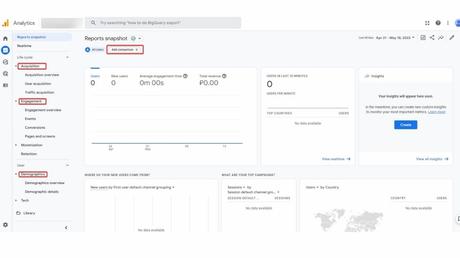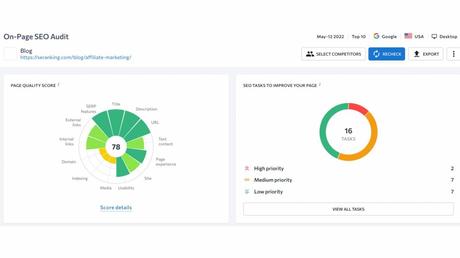
In 2022, content is the primary focus of marketing efforts, and there is an emphasis on quality over quantity. Brands produce fewer pieces of content. But the content is highly targeted and designed to elicit a specific reaction from the audience. However, there remains some underperforming content that needs a fix or an update.
With the proliferation of content, marketing teams need to be more strategic than ever in order to cut through the noise and reach their audiences. Those that are able to do so will find that content marketing is an incredibly effective way to build brand awareness and drive conversions.
 Learn how you can find and fix your underperforming content.
Learn how you can find and fix your underperforming content.
How to Detect and Improve Underperforming Content
Oftentimes, brands face the problem of underperforming content. If your content is underperforming, it means that it isn’t engaging enough. Or not reaching the audience that you had hoped for.
Keep on reading to find out what underperforming content is and how to detect and fix issues with it.
What is Underperforming Content?
Underperforming content is content that fails to meet the expectations of its audience. This can be due to a number of factors: including poor writing, incorrect or outdated information, or a lack of relevance to the audience.
To avoid these issues, it’s important to regularly assess your content to see how it’s performing. If you have content that isn’t performing well, it’s important to take a step back. Then, analyze why that might be. Use analytics to track metrics such as page views, time on page, and bounce rate.
If you see a sudden drop-off in any of these metrics, it’s a sign that your content is underperforming and needs to be updated or replaced.
Content drop reasons
There are many reasons why content may underperform. In any case, it is a frustrating situation for any business. Let’s have a deeper look at the reasons:
- Competition
With so many businesses vying for attention online, it’s easy for content to get lost in the shuffle. In order to stand out, content must be well-written, compelling, and relevant to the target audience.
- It does not match the user intent
User intent is the purpose for which a user is searching for information. If your content does not align with the user’s purpose and provides no information or answers to the question that the user is looking for, they are likely to leave your site. They do this without taking any action, which can hurt your performance.
- Wrong keywords optimization
Using the wrong keywords can result in your content being buried under a sea of other content that’s more relevant to the searcher’s query. You also might not be using enough of the right keywords. That can result in your content not being found by potential customers.
More Underperforming Content Drop Reasons
- Outdated information
In today’s rapidly-changing world, information can become outdated very quickly. Therefore, if your content is not regularly updated, it will soon become irrelevant. Outdated information can also lead to incorrect information. Incorrect information confuses and misleads your audience.
Source: The Verge
 Having old dates shown on your blog posts does not help readers with getting relevant information.
Having old dates shown on your blog posts does not help readers with getting relevant information.
- Poor formatting
Poor formatting can include things like using large blocks of text, not breaking up content into smaller paragraphs, and not using bullet points or lists. Additionally, using a lot of images or videos can make content appear cluttered and difficult to read. Content that is poorly formatted is off-putting to readers and can result in them quickly abandoning your website.
 Having content with no white space is bad for your reader’s eyes and they may not stay to read on.
Having content with no white space is bad for your reader’s eyes and they may not stay to read on.
- Unattractive design
When content is presented in an unattractive or difficult-to-navigate format, audiences are less likely to engage with it. Even if a poorly designed article had better content, chances are you would still prefer the better-designed one. This is because good design is visually appealing and makes reading more enjoyable.
- Content duplication
When content is duplicated, it can be difficult for search engines to determine which version is most relevant to a given search query. It can lead to search engines penalizing the site for having duplicate content. That can result in the site being pushed down the search engine rankings and losing organic traffic.
How to Detect Issues Affecting Your Content?
If you’re not seeing the results you want from your content, it may be time for a content audit. It can help you identify which pieces are underperforming and why. Once you know what’s not working, you can take steps to fix it.
There are a few different ways to approach a content audit:
Google Analytics
If you’re running a website, it’s important to track how users interact with your content. Google is a free tool that lets you analyze your organic channel. Organic traffic is the traffic that comes to your website from search engines.
This can be from people typing in your URL into the search bar, or from clicking on a link to your website from another website. By tracking things like page views, session duration, and bounce rate, you can get a good idea of how users are engaging with your site.
To get started, go to the Acquisition tab in Google Analytics and then click on Channels. There you’ll see an overview of organic traffic and the average number of pages visited, the average time on site, and the bounce rate.
You can also use other tabs in Google Analytics, like the Engagement tab, which can show you what pages are being visited, and the Demographics tab, which can show you who is visiting your site.
What’s more, you can compare the current period with the previous one to detect which pages have a decrease in traffic. Just go to the Reports tab, then click on the Add comparison button. This will show you a side-by-side comparison of the two periods. By using Google Analytics to analyze your organic traffic, you can get a better understanding of what’s working well and what’s not.

Search Engine Ranking
SE Ranking offers a powerful On-Page Audit tool that can help you analyze your webpages’ optimization score, and SERP competitors, and identify areas for improvement. The tool analyzes your URL in combination with your target keywords and checks the SERP for each keyword.
Then it compares your URL to your top organic rivals to identify what you should do with your content to beat the competition. SE Ranking’s tool also provides you with a great action plan on how to improve your on-page SEO of URLs that perform poorly.
On-page SEO Audit report on SE Ranking.

Technical Checks of Underperforming Content
If you’re not happy with the performance of your website’s content, there are a few technical checks you can perform using Google Search Console, or something similar, to help fix the problem:
-
Coverage report to check the crawlability and indexability
As part of ongoing SEO efforts, you can run a coverage report to check the crawlability and indexability of your website. To check for crawlability and indexability, use tools like Google Search Console or Bing Webmaster Tools.
They will allow you to see if there are any errors or issues with your site that are preventing it from being crawled or indexed. You can also use them to submit your sitemap to Google, which will help them crawl and index your website more effectively.
Finally, you can simply try to crawl or index your site yourself. If you can’t access your site or pages, then chances are that search engines can’t either.
-
Orphan Content
Is the content not being internally linked on your blog or website? Having all your content linked internally is important for your overall site’s SEO efforts. You want people to stay on your site longer and read through other related posts.
Having that content link back to another relevant post is important for your reader and for your SEO.
-
JavaScript check
When you are running a website, it is important to periodically check for JavaScript errors. These errors can cause your website to malfunction and can also be a security risk. You can use a browser extension or plugin that will give you a report of any JavaScript errors on your website. However, you can use an online service, which will scan your website and give you a report of any errors they find.
Upon completing a JavaScript check, don’t forget to tell your developer to fix the errors. Only one error can put a stop to rendering for Google, and your webpages won’t be indexed and found by users.
-
Duplication and cannibalization issues
Duplication occurs when there is more than one piece of content on your site that covers the same topic, while cannibalization happens when one piece of content is competing with another for the same keywords or search terms.
To check for these issues, you can use a tool like Screaming Frog. The tool will crawl your website and identify the pages that are targeting the same keyword. There are a few ways to resolve duplication and cannibalization issues:
- The first way is to make sure that each piece of content serves a different purpose. For example, if you have two blog posts that are both about the same topic, make sure that each post targets a different audience and uses different keywords.
- Another way is to use canonical tags. Canonical tags tell search engines which version of a piece of content is the original and should be indexed. This can be helpful if you have two similar pieces of content but don’t want both to be indexed by search engines.
Fixing Underperforming Content
Once you’ve identified the problem areas, it’s time to take action. If a piece of content is outdated, either delete it or update it. Or, if it’s poorly written, rewrite it.
However, if the underperforming content not getting any traffic, promote it more. Now, let’s discover what actions we should take:
Exclude Technical Aspects
If your website’s content is underperforming, there are a few potential technical aspects that could be to blame. First, check to see if all of your content is loading properly. If some of your content is “broken” or missing, that can definitely impact performance.
Second, make sure that your site is properly indexed and that your content uses the proper keywords and tags.
Finally, take a look at your website’s design and layout. If it’s outdated or not user-friendly, that could impact your content’s performance.
Refresh the Underperforming Content
As a content creator, it’s important to monitor current trends. There are a number of ways to stay up-to-date on trends, including following industry news, reading blogs and articles, and attending various conferences and events.
Of course, you don’t want to blindly follow trends. You should always be thinking about how they can be applied to your specific content and audience. But keeping an eye on trends can help you ensure that your content is fresh, relevant, and engaging.
Looking at new data can also help you keep information current and relevant to your readers. When looking for new statistics and facts, be sure to choose reliable sources. Look for data published by reputable organizations or individuals.
This will ensure that the information you are using is accurate. It’s important to keep your content fresh and relevant, so if you’re noticing that something isn’t working, don’t be afraid to make a change.
Understand Search Intent
Search intent is the purpose behind a user’s search. Understanding search intent is key to creating content that meets users’ needs. If your content isn’t performing as well as you’d like it to, take a look at the search intent behind the queries it’s ranking for.
Is your content fulfilling that intent? If not, you may need to revise your content and adjust it to better match what people are looking for to see an improvement in your performance.
For example, this page written by a well-respected online marketer named Ron from OneHourProfessor is about the best privacy policy generator software. Notice that the post starts with “What are the Best Privacy Policy Generators?” and then under those recommendations, he covers “What is a Privacy Policy Generator?”
Many bloggers would make the mistake of explaining what privacy policy generators are first to try to make their content more in-depth, but that wasn’t what the searcher primarily wanted. They wanted to know what the best privacy policy generator software is, so he covered that point first.
Improve Content to be Better than the TOP in the SERP
To make the content better than the top spot in the search engine results pages, you need to first understand why a particular piece of content is ranking higher than yours. Once you know the reasons why the content in the top spot is ranking higher than yours, you can start to make changes to improve your own content.
Some common reasons why content may rank higher than yours include:
- The content is more comprehensive and covers all the key points on the topic
- Better written and more engaging content
- The content is more visually appealing and uses multimedia
- Updated content more frequently
 Improve your underperforming content to rank better and help your readers at the same time.
Improve your underperforming content to rank better and help your readers at the same time.
Structuring the Content
Is the content not performing because it’s not relevant to your audience, or because it’s not well-structured? If it’s the latter, then the solution is to focus on restructuring it so that it’s more effective.
This means breaking it down into smaller, more manageable chunks, and then organizing it in a way that makes sense. You can also add headings and subheadings to make it easier to navigate, or use bullet points or numbered lists to highlight key information.
Moreover, by adding a schema markup you give search engines more information about your content, which can help them to index it more effectively and improve your website’s search ranking. In addition, if a website’s content is confusing or hard to read, a well-designed layout can make it much easier to understand.
Likewise, if a poorly organized website is slow, a good design is much easier to navigate. By making your content more digestible, you increase the likelihood that your audience will stick with it.
And that means better results for you.
Adding Videos, Infographics, and Other Engagement Actions
If you have content on your website that isn’t performing as well as you’d like, there are a few things you can do to try and fix it. One option is to add videos and infographics to the page. It will help to make your content more visually appealing and interesting, break up text-heavy content, and encourage people to stay on the page longer and interact with it more.
Another option is to take a look at your engagement actions and see if there’s anything you can do to make them more effective. Maybe you need to add more CTAs or make them more visible.
By adding comments, likes, and shares, you can increase the visibility of your content and encourage people to interact with it. Moreover, you can try repurposing your content into different formats. Like video or podcast, to reach a wider audience.
Claim your first 10,000 FREE points to try Jasper ai today for FREE to write more & better contentConclusion: How to Find and Fix Underperforming Content
If your content is underperforming, it’s important to take a step back and figure out why. Is it because the topic is uninteresting? Are there technical issues that need a fix? Are the visuals unappealing? Once you’ve pinpointed the problem, you can start to fix it using the methods we’ve mentioned.
If the topic is uninteresting, try to approach it from a different angle. Then, if there are some technical issues, try to fix them as soon as possible. If the content is out of date, try to stay up-to-date with current trends and news. That way you can make it more relevant.
Whatever the problem is, there’s probably a way to fix it. So don’t give up on your content just yet. With a little effort, you can turn it into something that your audience will readily want to consume.
What are you doing to fix your underperforming content? Let’s discuss this in the comments below.

